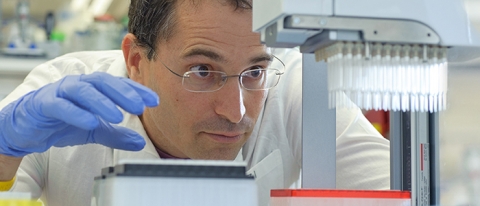Beyond CRISPR
We can now edit the genome—and see the results
Briefs

The new genome-editing tool CRISPR is taking the science world by storm because of its remarkable ability to snip out or insert a new gene into a genetic sequence.
It has helped propel hundreds of scientific developments from removing malaria from mosquitos to treating muscular dystrophy. But scientists still struggle with a major limitation of the tool- getting a deeper understanding of what actually happens after the editing job.
Now, Prof. Ido Amit and his colleagues at the Weizmann Institute of Science has combined CRISPR with a second tool, called single-cell RNA sequencing, which enables scientists to actively manipulate genes in cells, and then see the results. The breakthrough, published in Cell in December, may have major implications for better understanding and treating a vast array of diseases and conditions from Alzheimer’s to cancer.
More than a decade ago, the Human Genome Project—the international effort to sequence human DNA—was completed. That treasure of information led to countless new insights surrounding genetic mutations in disease, genotyping of viruses to direct treatment, advances in forensic science, new food and plant varieties and more. A few years ago, CRISPR was first discovered in bacteria and has since enabled scientists to edit genomes of humans, bacteria, viruses, and plants with unprecedented precision, efficiency, and flexibility. Its clinical use in humans is just over the horizon.
“CRISPR, on its own, is a blunt research tool, since we often have trouble observing or understanding the outcomes of genomic editing,” says Prof. Amit, a member of the Department of Immunology. Dr. Diego Jaitin, a staff scientist in Prof. Amit’s lab, adds, “Most studies so far have looked for black-or-white types of effects, but the majority of processes in the body are complex and even chaotic. We wanted to get the picture in full color, and in high-definition.”
‘A new molecular microscope’
Single-cell RNA sequencing, however, introduces nuance. It involves sequencing the messenger RNA molecules in each individual cell - messages that indicate cellular activity. The sequencing process elucidates the molecular makeup of each cell and helps discern a detailed range of cell identities and functions in a given cell population.
“It is a new molecular microscope,” providing a snapshot of cells or tissues, says Prof. Amit, who worked with Dr. Assaf Weiner and Dr. Ido Yofe on the study.
The team’s challenge, was to adapt CRISPR so it could be used in combination with single-cell sequencing. According to Dr. Weiner, it required the exact identification of each cell, which involved sophisticated algorithms and lots of data analysis. Combining the two methods, can provide new insight that neither method, alone, would be able to yield. The results can be observed in a resolution never before achieved for this type of study, and quickly, says Dr. Yofe. They expect it will pave the way for many new investigations in a range of scientific disciplines.
The research results were published together with descriptions of a similar technology developed at the Broad Institute in Boston and the University the California, San Francisco.
“The advent of CRISPR presented a true leap in the ability to understand and start editing immune circuits,” says Prof. Amit. “We hope that our approach will be the next leap forward, providing, among other things, the ability to engineer immune cells for immunotherapy.”
Prof. Ido Amit's research is supported by the Benoziyo Endowment Fund for the Advancement of Science; the David and Fela Shapell Family Foundation INCPM Fund for Preclinical Studies; the Leona M. and Harry B. Helmsley Charitable Trust; the Rosenwasser Fund for Biomedical Research; the Alan and Laraine Fischer Foundation; Isa Lior, Israel; Drs. Herbert and Esther Hecht, Beverly Hills, CA; the Comisaroff Family Trust; Rising Tide; the David M. Polen Charitable Trust; the BLG Trust; and Mr. and Mrs. Harold Hirshberg, Park Ridge, NJ. Prof. Amit is the recipient of the Helen and Martin Kimmel Award for Innovative Investigation.

Prof. Ido Amit